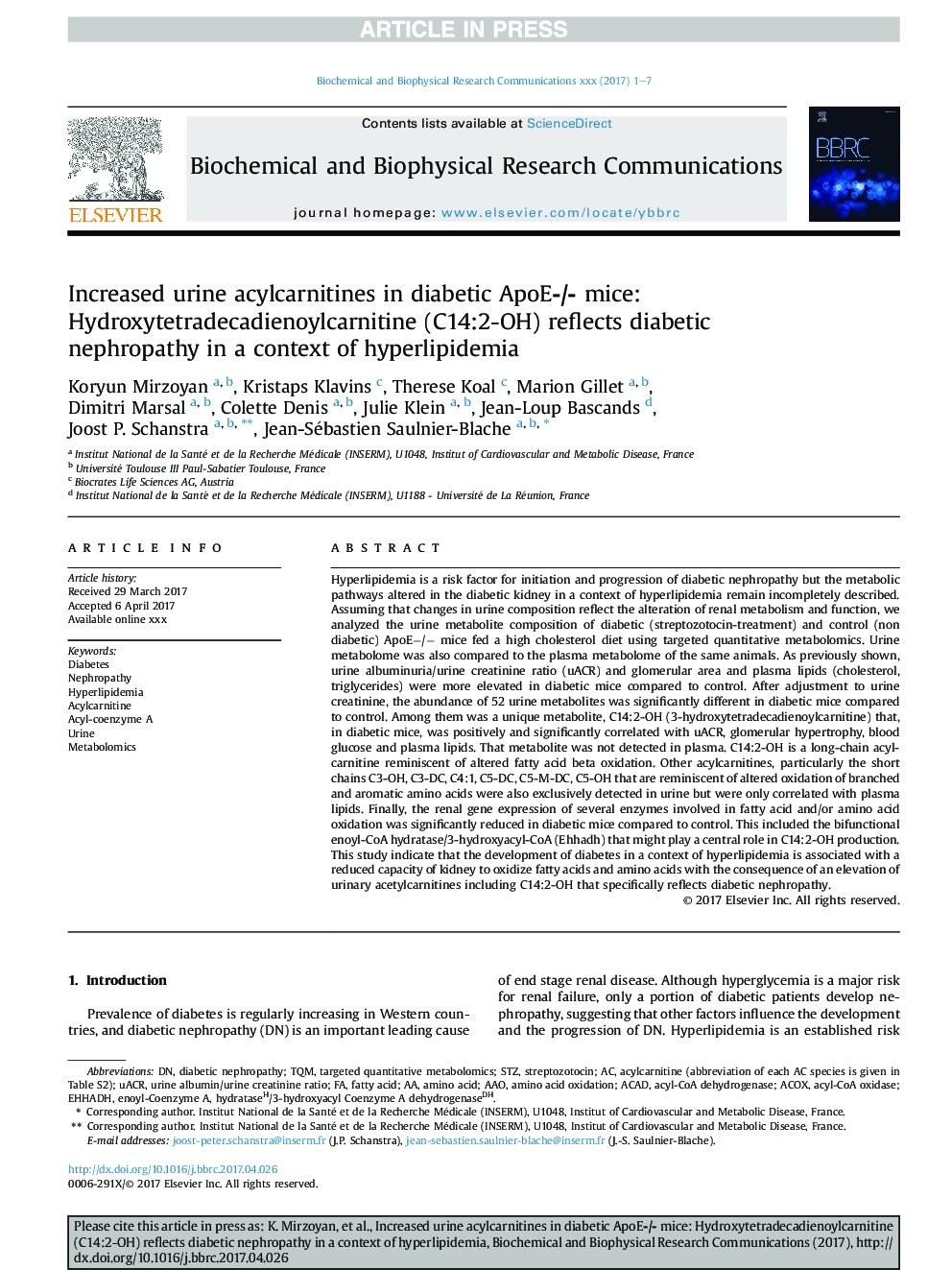| کد مقاله | کد نشریه | سال انتشار | مقاله انگلیسی | نسخه تمام متن |
|---|---|---|---|---|
| 5505752 | 1400277 | 2017 | 7 صفحه PDF | دانلود رایگان |
عنوان انگلیسی مقاله ISI
Increased urine acylcarnitines in diabetic ApoE-/- mice: Hydroxytetradecadienoylcarnitine (C14:2-OH) reflects diabetic nephropathy in a context of hyperlipidemia
دانلود مقاله + سفارش ترجمه
دانلود مقاله ISI انگلیسی
رایگان برای ایرانیان
کلمات کلیدی
TQMAcyl-coenzyme AUACRAAOacyl-CoA dehydrogenaseSTZacyl-CoA oxidaseACAdACOXAcylcarnitine - آسیکارنیتینamino acid - آمینو اسیدUrine - ادرار streptozotocin - استرپتوزوتوسینFatty acid - اسید چربAmino acid oxidation - اکسیداسیون اسید آمینهDiabetes - بیماری قندMetabolomics - متابولومیکNephropathy - نفروپاتیDiabetic nephropathy - نفروپاتی دیابتیHyperlipidemia - هیپرلیپیدمی
موضوعات مرتبط
علوم زیستی و بیوفناوری
بیوشیمی، ژنتیک و زیست شناسی مولکولی
زیست شیمی
پیش نمایش صفحه اول مقاله

چکیده انگلیسی
Hyperlipidemia is a risk factor for initiation and progression of diabetic nephropathy but the metabolic pathways altered in the diabetic kidney in a context of hyperlipidemia remain incompletely described. Assuming that changes in urine composition reflect the alteration of renal metabolism and function, we analyzed the urine metabolite composition of diabetic (streptozotocin-treatment) and control (non diabetic) ApoEâ/â mice fed a high cholesterol diet using targeted quantitative metabolomics. Urine metabolome was also compared to the plasma metabolome of the same animals. As previously shown, urine albuminuria/urine creatinine ratio (uACR) and glomerular area and plasma lipids (cholesterol, triglycerides) were more elevated in diabetic mice compared to control. After adjustment to urine creatinine, the abundance of 52 urine metabolites was significantly different in diabetic mice compared to control. Among them was a unique metabolite, C14:2-OH (3-hydroxytetradecadienoylcarnitine) that, in diabetic mice, was positively and significantly correlated with uACR, glomerular hypertrophy, blood glucose and plasma lipids. That metabolite was not detected in plasma. C14:2-OH is a long-chain acylcarnitine reminiscent of altered fatty acid beta oxidation. Other acylcarnitines, particularly the short chains C3-OH, C3-DC, C4:1, C5-DC, C5-M-DC, C5-OH that are reminiscent of altered oxidation of branched and aromatic amino acids were also exclusively detected in urine but were only correlated with plasma lipids. Finally, the renal gene expression of several enzymes involved in fatty acid and/or amino acid oxidation was significantly reduced in diabetic mice compared to control. This included the bifunctional enoyl-CoA hydratase/3-hydroxyacyl-CoA (Ehhadh) that might play a central role in C14:2-OH production. This study indicate that the development of diabetes in a context of hyperlipidemia is associated with a reduced capacity of kidney to oxidize fatty acids and amino acids with the consequence of an elevation of urinary acetylcarnitines including C14:2-OH that specifically reflects diabetic nephropathy.
ناشر
Database: Elsevier - ScienceDirect (ساینس دایرکت)
Journal: Biochemical and Biophysical Research Communications - Volume 487, Issue 1, 20 May 2017, Pages 109-115
Journal: Biochemical and Biophysical Research Communications - Volume 487, Issue 1, 20 May 2017, Pages 109-115
نویسندگان
Koryun Mirzoyan, Kristaps Klavins, Therese Koal, Marion Gillet, Dimitri Marsal, Colette Denis, Julie Klein, Jean-Loup Bascands, Joost P. Schanstra, Jean-Sébastien Saulnier-Blache,